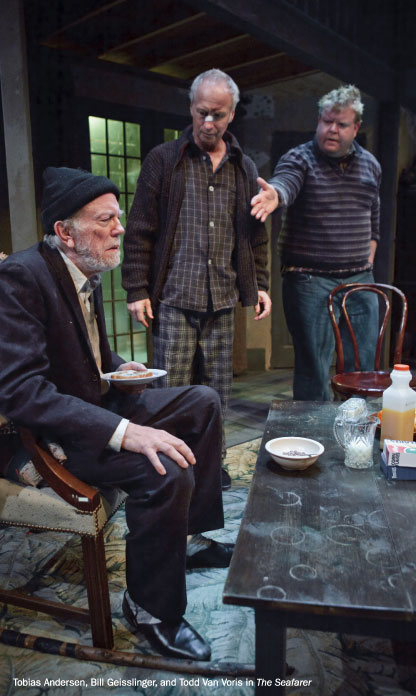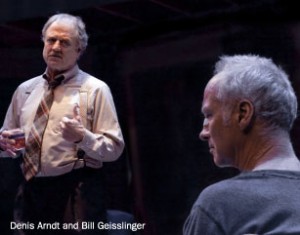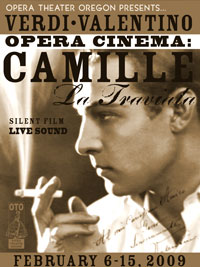
What with arts politics and scratchy throat and other everyday interruptions I’ve avoided actually writing about any art since talking about Portland Opera’s The Turn of the Screw and the finale of the Fertile Ground new-plays festival a couple of weeks ago.
But I don’t want Artists Repertory Theatre‘s brilliant version of The Seafarer and Opera Theater Oregon‘s campy but gorgeous Camille/La Traviata to get any farther in the rear view mirror without picking up my virtual pen. Both shows have ended their runs, which turns this into something more of an afterglow than what’s sometimes known in the biz as a “money review.”
Still, darned near everything in The Seafarer was pretty much right on the money, beginning with Irishman Conor McPherson‘s multiply layered script and extending to Allen Nause’s precise yet lively direction of one of the best ensemble casts you’re likely to see in a long while.
McPherson broke on the scene in 1999 with The Weir, when he was still in his late 20s, and although he’s become a leading voice in contemporary theater he’s something of a classicist: The Seafarer, which was first produced in 2006, is an old-fashioned play in a lot of good ways. It revels in language (the way McPherson lobs curses is much funnier and, dare I say, humanitarian than the way Mamet usually does). It’s a “well-made play,” a form that’s fallen out of fashion but has historical staying power. It plays with checks and balances and dramatic weight, encouraging you to shift your view now and again about who the “central” character in this cosmic-showdown drama really is. It’s — hold your breath here — entertaining, a basic value that all too often gets lost in the name of cultural relevance and Art.
And it has what I like to think of as the “sponge effect,” a springiness in the writing that doesn’t dictate every detail but gives good actors something to dig into with zest and make their own. McPherson has serious things on his mind but he never forgets his audience: He rewards it with switchbacks and surprises and a whole lot of genuine if morbid laughter (yes, he has us laughing at the particulars of a lost soul’s impending plummet into Hell). With a McPherson play you get to enjoy the palpable pleasure of watching fine actors hit some theatrical fastballs over the fence, then go home and let the subtext of the game sink in.
 The story of The Seafarer, at heart, is as old as the idea of the duality of the human soul — or the duality of the cosmos, in which a force called good contests with a force called evil over the ultimate disposition of that shabby yet somehow supremely important wisp of somethingness that we like to think of as our eternal essence. This is another part of McPherson’s old-fashionedness: At least for the purposes of the drama, he contends that there is a soul, and it will live on one way or the other, and it is worth fighting for. Make no mistake, there are theological considerations to this script. Do we earn salvation? Can we lose it? Is God a god of justice, or a god of mercy, or a god of something else? What are the natures of sin and human redemption? What is the Devil’s due?
The story of The Seafarer, at heart, is as old as the idea of the duality of the human soul — or the duality of the cosmos, in which a force called good contests with a force called evil over the ultimate disposition of that shabby yet somehow supremely important wisp of somethingness that we like to think of as our eternal essence. This is another part of McPherson’s old-fashionedness: At least for the purposes of the drama, he contends that there is a soul, and it will live on one way or the other, and it is worth fighting for. Make no mistake, there are theological considerations to this script. Do we earn salvation? Can we lose it? Is God a god of justice, or a god of mercy, or a god of something else? What are the natures of sin and human redemption? What is the Devil’s due?
Ah, the Devil. If he’s not the central character here, he’s certainly the catalytic one. It’s Christmas Eve in a garbage-strewn hole-in-the-wall north of Dublin, a place littered with junk-food wrappings and cigarette stubs and empty beer cans and — oh, over there — the wracked hulk of an old blind drunk hacking and wheezing and slowly rising from the rubble of tattered bed things strewn on the floor. That would be Richard (Tobias Andersen, in a drippingly physical, coarsely acerbic and illuminatingly optimistic performance), the supposedly helpless proprietor of this dump, a testy chunk of phlegm who barks and natters like Ubu Roi — imperious king of the dung hill.
Caring for him, and strangely following his orders, is Richard’s tightly coiled and precariously controlled brother Sharky, a notorious drunk and hothead and womanizer who’s on the wagon and trying to maintain after losing a decent job by getting a little too friendly with his boss’s wife. Bill Geisslinger is wonderfully cool and hot in this role, a fascinating contradiction of attraction and repellence: the smartest guy in the room, and the one who does the dumbest things. The one who keeps things going, and the one who’s utterly unreliable. The one who fights furiously for his life, and the one who’s let himself sink into despair.
Their bumbling friend Ivan (Todd Van Voris, in a deliciously sad-hilarious performance that reins itself in just this side of hamminess) prompts enough laughter from his morning-after woes to give a real drunk a splitting headache — and late in the play, in the clutches when Ivan’s own dark secret spills out and every nuance counts, Van Voris deepens into a brief but bleak pain that explains the not-so-comic dissolution of Ivan’s blowing-in-the-wind existence. Somewhere Ivan has a wife, whom he feels cowed by, but he’d rather escape into the bosom of the boys and the booze, and you get the sense that, like these other men, what his life is missing most is the calming, balancing influence of domesticity, which for one reason or another, each seems to feel he doesn’t deserve.
Into this oddly comic rotting fleshpile walks Sharky’s old nemesis Nicky (Leif Norby), who married Sharky’s wife after Sharky blew that chapter of his life, and a natty stranger, the meticulous Mr. Lockhart (Denis Arndt). Mr. Lockhart is, of course, the Devil, and on this night he and the boys are going to play cards, and the ultimate wager, the calling-in of an old debt, is Sharky’s soul — a pitiful, seemingly worthless thing, but then, it’s Sharky’s own, and he’d rather keep it himself. It seems that the unseen but omnipresent character in The Seafarer, God, favors Sharky’s hand, too.
Longtime theater followers in the Pacific Northwest remember Arndt well. Like Geisslinger, he spent many years as a leading figure at the Oregon Shakespeare Festival, creating indelible characters in plays as diverse as Coriolanus, Wild Oats, King Lear, Long Day’s Journey Into Night, and Hickey in The Iceman Cometh. He has, as they say, gravitas, but more than that, danger. What’s always struck me about Arndt’s performances is how meticulously thought out yet precipitously on the edge they are. He takes you to the tipping point. And while his body does amazing things — Marty Hughley, in his fine review of The Seafarer for The Oregonian, noted that Arndt “walks as if Lockhart, uncomfortable in a borrowed form, finds the human knee a vaguely ridiculous mechanism” — it’s the workings of his mind that truly fascinate. He has a way of turning his characters’ thought processes inside out, so you can almost see his brain furiously working: tick-tick-tick.
In this play Mr. Lockhart’s crisp clean look stands out. He’s genial (at least, at first) yet separated from the slovenliness around him, and gradually you begin to see not just his disdain for the loamy filth of this all-too-human gathering but also a fear of it, and a basic, unbridgeable incomprehension. What is it about these pitiable, short-lived creatures that makes God prefer them to him? In Arndt’s, and McPherson’s, calculation, what makes the Devil the Devil is a void: He simply can’t understand the messy essence, the striving and failing, the hurting and comforting, the cowardliness and occasional bravery, of being human and being alive. Those things elude Mr. Lockhart as surely as the divinity of Mozart eludes Salieri in Amadeus. And for that, the Devil is eternally locked out, eternally on the outside. He holds the losing hand.
Considering the quality of the play and the performances, it’s good to report that the physical and design aspects of Artists Rep’s production more than held up their end of the bargain: Jacqueline Davis’s pitch-perfect costumes; Jeff Seats’ bi-level, suitably run-down set; Drew Foster’s litter of props; Jeff Forbes’ sensitive lighting; Rodolfo Ortega’s sound. What we have here — or had here — is a complete production.
The glory, and the sadness, of live theater is that it’s ephemeral: Once it’s gone, it’s gone. We can’t experience it again. It’s somehow shocking that a work of art like this simply is no more, and yet that’s also the measure of its sweetness. From this point on it lives only in our hearts and minds. And that’s the winning hand.
*******************************
In the 1988 movie comedy “Working Girl,” Melanie Griffith solves a seemingly intractable problem for a client who wants to buy a string of television stations but can’t swing the deal. She tells him the story of a truck that got stuck in an underpass and couldn’t move forward or backward until a little boy suggested, “Let the air out of the tires.” Let the air out of the tires, Griffith said: If TV doesn’t work, buy radio stations instead.
 Opera Theater Oregon has become a resounding success by letting the air out of the tires of the hyperinflated world of grand opera, a world that strikes fear into a lot of hearts. OTO turns the fear factor on its head by being almost puppy-dog friendly. It performs in small spaces with small casts, usually with drinks and snacks available and sometimes with extra touches like a wandering cigarette girl hawking candy smokes and bubble-gum cigars. For its recently concluded Camille/La Traviata it included an audience singalong and some sweet singing and banjo playing by a talented performer of vintage popular tunes whose name I unfortunately didn’t catch.
Opera Theater Oregon has become a resounding success by letting the air out of the tires of the hyperinflated world of grand opera, a world that strikes fear into a lot of hearts. OTO turns the fear factor on its head by being almost puppy-dog friendly. It performs in small spaces with small casts, usually with drinks and snacks available and sometimes with extra touches like a wandering cigarette girl hawking candy smokes and bubble-gum cigars. For its recently concluded Camille/La Traviata it included an audience singalong and some sweet singing and banjo playing by a talented performer of vintage popular tunes whose name I unfortunately didn’t catch.
So it’s small-scale, and for a lot of people that’s reassuring. But it works because the music isn’t just accessible, it’s well-performed. In a small space you don’t need the kind of giant voice required to perform in a 3,000 or 4,000 seat hall, and that opens some plum roles to a much broader group of singers, some of whom are talented but young and still developing.
Oh — and it doesn’t hurt that OTO has found a way to successfully blend opera and the campy but beguiling world of silent films. This time around the marriage was between Verdi’s 1853 opera and Camille, the 1921 movie version of the same Alexandre Dumas fils story, starring the sad-eyed, wild-haired vamp Alla Nazimova as the doomed Lady of the Camellias and a young Rudolph Valentino as the country lad who sees through her cynical exterior to her heart of gold, which unfortunately resides right next to her lungs of consumption.
 One of the advantages of doing opera cinema, at least from a smaller-is-better perspective, is that the silent films are much shorter than the full operas and therefore require creative editing, a skill at which OTO director Katie Taylor has proven herself adept. The swift running time fits well with the visual richness of the performance (you watch the film on a large screen, while the singers perform to the side behind music stands).
One of the advantages of doing opera cinema, at least from a smaller-is-better perspective, is that the silent films are much shorter than the full operas and therefore require creative editing, a skill at which OTO director Katie Taylor has proven herself adept. The swift running time fits well with the visual richness of the performance (you watch the film on a large screen, while the singers perform to the side behind music stands).
Camille/La Traviata was a little bigger than previous OTO shows, but still compact. It included, besides piano, a string quartet and a 10-singer chorus in addition to the six character soloists. All of that provided a welcome fullness of sound, and a nice setting for the lovely tone of soprano Natasha Risotto as the camellia-loving heroine. Tenor Leslie W. Green, in the Valentino role; baritone James Rose, as the hero’s rakish friend; and Bre Gregg, in a bevy of supporting roles, helped give the evening a burnished musical appeal.
To know your limitations and make the most of them is a very good thing: You don’t always need all that air in your tires. Besides, once you sell a crowd on the charms of chamber-sized opera, they might be ready to pump up the volume and dive into the big-scale version, too.
————————————
Photos from The Seafarer by OWEN CAREY